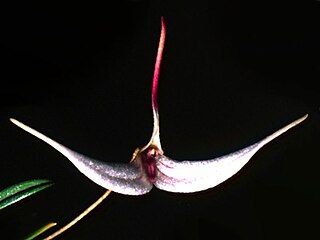Genus is a taxonomic rank used in the biological classification of living and fossil organisms as well as viruses. In the hierarchy of biological classification, genus comes above species and below family. In binomial nomenclature, the genus name forms the first part of the binomial species name for each species within the genus.

In taxonomy, binomial nomenclature, also called binary nomenclature, is a formal system of naming species of living things by giving each a name composed of two parts, both of which use Latin grammatical forms, although they can be based on words from other languages. Such a name is called a binomial name, a binomen, binominal name, or a scientific name; more informally it is also historically called a Latin name. In the ICZN, the system is also called binominal nomenclature, "binomi'N'al" with an "N" before the "al", which is not a typographic error, meaning "two-name naming system".

Columbidae is a bird family consisting of doves and pigeons. It is the only family in the order Columbiformes. These are stout-bodied birds with short necks and short slender bills that in some species feature fleshy ceres. They primarily feed on plants, and can be taxonomically divided amongst granivores, that feed mostly on the ground on seeds, and frugivores, that feed mostly on fruits, from branches. The family occurs worldwide, often in close proximity with humans, but the greatest variety is in the Indomalayan and Australasian realms.

Cuckoos are birds in the Cuculidae family, the sole taxon in the order Cuculiformes. The cuckoo family includes the common or European cuckoo, roadrunners, koels, malkohas, couas, coucals, and anis. The coucals and anis are sometimes separated as distinct families, the Centropodidae and Crotophagidae, respectively. The cuckoo order Cuculiformes is one of three that make up the Otidimorphae, the other two being the turacos and the bustards. The family Cuculidae contains 150 species, which are divided into 33 genera.

Primula is a genus of herbaceous flowering plants in the family Primulaceae. They include the primrose, a familiar wildflower of banks and verges. Other common species are P. auricula (auricula), P. veris (cowslip), and P. elatior (oxlip). These species and many others are valued for their ornamental flowers. They have been extensively cultivated and hybridised. Primula are native to the temperate Northern Hemisphere, south into tropical mountains in Ethiopia, Indonesia, and New Guinea, and in temperate southern South America. Almost half of the known species are from the Himalayas.

Starlings are small to medium-sized passerine birds in the family Sturnidae. The Sturnidae are named for the genus Sturnus, which in turn comes from the Latin word for starling, sturnus. The family contains 128 species which are divided into 36 genera. Many Asian species, particularly the larger ones, are called mynas, and many African species are known as glossy starlings because of their iridescent plumage. Starlings are native to Europe, Asia, and Africa, as well as northern Australia and the islands of the tropical Pacific. Several European and Asian species have been introduced to these areas, as well as North America, Hawaii, and New Zealand, where they generally compete for habitats with native birds and are considered to be invasive species. The starling species familiar to most people in Europe and North America is the common starling, and throughout much of Asia and the Pacific, the common myna is indeed common.

Hakea is a genus of about 150 species of plants in the Family Proteaceae, endemic to Australia. They are shrubs or small trees with leaves that are sometimes flat, otherwise circular in cross section in which case they are sometimes divided. The flowers are usually arranged in groups in leaf axils and resemble those of other genera, especially Grevillea. Hakeas have woody fruit which distinguishes them from grevilleas which have non-woody fruit which release the seeds as they mature. Hakeas are found in every state of Australia with the highest species diversity being found in the south west of Western Australia.
Andreettaea is a genus of flowering plant in the family Orchidaceae, native to southern Mexico, the West Indies and tropical South America. The genus was established in 1978. Some sources treat the genus as a synonym of Pleurothallis.

Blackheath is a 141.6-hectare (350-acre) biological Site of Special Scientific Interest south-east of Guildford in Surrey.

Trisetella is a genus of orchids, native to Central and South America. Twelve of the 23 currently known species are endemic to Ecuador. They bear small flowers with fused sepals and fused petals. The synsepal bears three hair-like tails, which is the namesake of Trisetella.

Bisporella is a genus of fungi in the family Helotiaceae. As of March 2022, the nomenclatural database Index Fungorum lists 31 species in the genus.

Dendrothele is a genus of fungi in the family Corticiaceae. According to a 2008 estimate, the genus has 36 widely distributed species.

Camptorrhiza is a genus of plants native to India and southern Africa. It contains two recognized species:

Clavularia is a genus of corals in the family Clavulariidae. They are often referred by the common names star polyps or clove polyps.

Anthelia is a genus of soft corals in the family Xeniidae.
Diosma is a genus of flowering plants in the family Rutaceae, native to Cape Provinces of South Africa. The genus was first described by Carl Linnaeus in 1753.

Hakea strumosa is a shrub in the family Proteacea endemic to an area in the Wheatbelt, Great Southern and the Goldfields-Esperance regions of Western Australia. A dense, very prickly shrub with a profusion of small, deep pink or red flowers in spring.
Pterolophia strumosa is a species of beetle in the family Cerambycidae. It was described by Francis Polkinghorne Pascoe in 1865, originally under the genus Praonetha. It is known from Australia. It contains the varietas Pterolophia strumosa var. blackburni.
Cota is a genus of pygmy grasshoppers in the family Tetrigidae. There are at least three described species in Cota.













